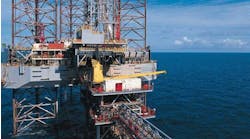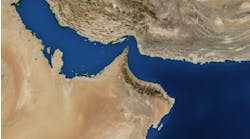Incorporating lighter, smaller designs critical to deep and ultradeep rigs
Rick Von Flatern
Technology Editor
An artists rendering of Transocean's dual activity rig, Discoverer Enterprise.Huge oil and gas finds in the deep waters of the Gulf of Mexico and elsewhere are confirming what most petroleum professionals had already strongly suspected - the industry's future is beyond the continental shelves. In the North Sea, operators have committed to the deepwater and harsh environment north and west of the Shetlands, and in the Gulf of Mexico, development of prospects in 7,500-ft depths are well into planning stages even as recent Gulf of Mexico finds exceed initial production expectations.
To drilling contractors, deeper water means escalating dryhole costs from long trip times and deck space and variable load capacities that diminish with each mile the rig moves from shore.
Deep water challenges, coming as they did on the heels of ten years of extreme frugality, have brought creative, technical responses from all sectors of the industry - from increasingly sophisticated subsea completion strategies to unprecedented forays into resource sharing. And now that 10,000-ft water depth environments are about to become a reality, the industry is turning its attention to building the necessary drilling equipment.
Several major drilling contractors have targeted the ultradeep waters of 7,000 ft and beyond with dynamically positioned drillships. One of them has begun construction on the hull of a vessel with two completely equipped drill floors and though the unit will be capable of drilling two wells at once its real advantage is to reduce drilling days to TD of a single well bore.
A US-based company has invoked a single concept for use in both a compensating crown and riser tensioner system that reduces fixed weight while providing added deck space. The company believes its designs can play an intricate role in bringing 1,200-ft water depth capable rigs to beyond the 3,000-ft mark.
Cutting flat times
Unlike semisubmersibles, dynamically positioned drill ships have an abundance of both load capacity and deck space. Transocean Offshore has chosen to use these qualities to save operators money by saving time in critical, non-drilling activities in deep- and ultradeep waters.
The Discoverer Enterprise, the first of several new floaters to be commissioned in the past year, has been designed as a dual activity rig with two, side-by-side rotary tables, topdrives and traveling blocks, and drawworks. Two drilling areas separated by 40 ft will be built on the 80 ft by 80 ft drill floor. (Typical fourth-generation semisubmersible drill floors are about 40 ft x 40 ft). While its mud pumps and fluid handling capacities make the rig easily capable of drilling two well bores at once, designers envision it saving operators money through equipment and space redundancies that shorten the 'flat spots' on individual well depth vs. days drilling curves.
Flat spots occur on the graph when time passes without any borehole progress. They are created by such indispensable operations as landing or changing BOPs, casing and cementing, and logging runs. Though they cannot be eliminated entirely, it is the goal of the Discoverer Enterprise's designers to significantly reduce the time (and money) they consume by using one drill floor to drill ahead and the other to prepare for flat spot operations.
The concept is especially sound in deepwater operations, where every trip must include hundreds of connections between the seafloor and the drill floor. When the Discoverer Enterprise moves onto location for the first time, it will be moored with its auxiliary rotary table aligned on the critical path above the spot on the seafloor where the well is to be spud. The first two hole sizes can be drilled riserless and first two casing strings run and cemented through that rotary.
Meanwhile, the preliminary rotary table and drill equipment is being used to make up and run the BOP to near the sea floor. When the second casing string is run and cemented, the stinger and running tool are removed and the entire drill ship is maneuvered by its moorings until the BOP is in position to be landed. Drilling can then resume with considerable time savings between the operations. And since the crown block is 240 ft above the drill floor, "quadruples" can be made up and stood back in the derrick, further shortening the drilling time by reducing the number of stops made for connections during the drilling process.
During the remainder of the drilling operation, done through the primary rotary table, the secondary table, automated pipe handler, and traveling block are used to make up "triples" of the next casing section - a significant efficiency gain over the traditional practice of running single stands from the pipe rack, the principal contributor to drilling-curve flat spots. Transocean estimates its drill ship's ability to make up tubulars will improve exploration drilling efficiency 15% per well and improve development drilling time by 40%.
The Discoverer Enterprise's size (835-ft long by 125-ft beam) provides its deepwater clients other advantages, among them storage capacity of 100,000 bbl of crude and 20,000 b/d and 70 MMc/d of gas processing capabilities. And two 30,000 bbl active mud system storage capacity means drillers can switch almost instantaneously from water-based to oil-based drilling mud system or to prepare completion fluids without delays to clean pits.
The ship will be ready to begin a minimum three-year contract in the US Gulf of Mexico for Amoco sometime in the second half of 1998, according to Transocean's director of investor relations, Jeff Chastain. The contract for about $200 million over three years, equates to a dayrate of about $182,000.
The hull is currently being built at the Astilleros y Talleres del Noroeste (Astano) shipyard in La Coruna, Spain and is expected to be completed by January 1, 1998. Topside construction is in the midst of the bidding process. As the final product leaves the shipyard it will be capable of drilling in 7,000-ft waters and easily fitted to 10,000 ft. Full ship's compliment is about 200.
Flow control tensioner
Deepwater operations' large deckload requirements leave contractors the choice between high cost dynamically-positioned drill ships or fourth- and fifth-generation semisubmersibles. Semis have some stability advantage over drillships and, except in very deep water, are less expensive to build. But they do not have anything like the available deckload capacity of a drillship.
Flow Control believes it can make the most of available semisubmersibles with a lighter riser tensioner that can be placed below the decks, freeing deck space and load in a single, if basic, design change. The tensioner, which is fixed to the rig so as to distribute its loads not to the substructure but to the rig columns at or below the water line, is lighter than traditional riser tensioners and uses no wire cables. Its designers claim the tensioner can add up to three million lb. of available deckload to upgrades without the addition of thousands of tons of steel in the form of sponsons and other standard upgrade practices.
Though not yet formally named, Control Flow engineers refer to it as a direct acting riser tensioner because one end of the compression cylinders at the heart of the design is connected directly to the slipjoint rather than through a traditional system of sheaves and wire rope.
The design is not entirely new. The concept patent upon which it is based was granted to Control Flow's Dave Cherbonnier in 1987. At the time the technology was to be used as a system to lift and lower a helipad being built for the US presidential retreat at Camp David, Maryland.
Upon completion and submission of the helipad design, Cherbonnier took his angled compression cylinder design, which he had dubbed "Phoenix," to the oil industry in the form of a compensating crown. Though well received, the oil industry was not in a position to exploit the concept. "The very first one was the victim of an oil industry in shambles," Cherbonnier said.
The Phoenix design offered a 600,000-lb capacity (about all the oil industry could use at the time) using 7-in. cylinder rods. But because the 7-in. diameter piston rods gave the compensator a spindly look atop bulky drilling structures, Cherbonnier expanded their diameter to 12 in. and suddenly had a system that could handle 1.2 million lb. ABS certified the engineering in 1988.
When asked by industry experts if his compensator's excess capacity could be used for riser tensioning, Cherbonnier recognized the logic but balked at the application. "My thought was to use 600,000 lb. for the crown and the balance on the riser through cables, but that didn't make sense," he said. "And then when I realized riser tensioner load would be doubling (in deepwater) my first consideration was to improve existing design but that didn't address wire rope, deckload, and space. And then we realized, let's just directly connect it below the waterline and instead of carrying the crown we are carrying the outer barrel of the slip joint."
The location and configuration of the frame upon which the tensioner rests gives rise to some interesting possibilities beyond its initial purpose. For instance, the frame could easily be designed to accommodate a platform of sufficient size to support a diverter. With the diverter thus at the water line, pistoning of the fluid column in the riser as a result of rig movement could be essentially eliminated - a particularly significant consideration in slimhole applications. And with proper planning, shakers could be placed below the substructure, also supported by the tensioner frame, and the first stages of mud treatment accomplished well below decks while freeing yet more deck space.
Cherbonnier said the direct riser tensioner concept is ready to be incorporated into the upgrade or newbuild design of any contractor open to its advantages at, Control Flow officials estimate, an initial capital outlay about 20% less than that of other million-lb capacity tensioner systems.
Copyright 1997 Oil & Gas Journal. All Rights Reserved.


